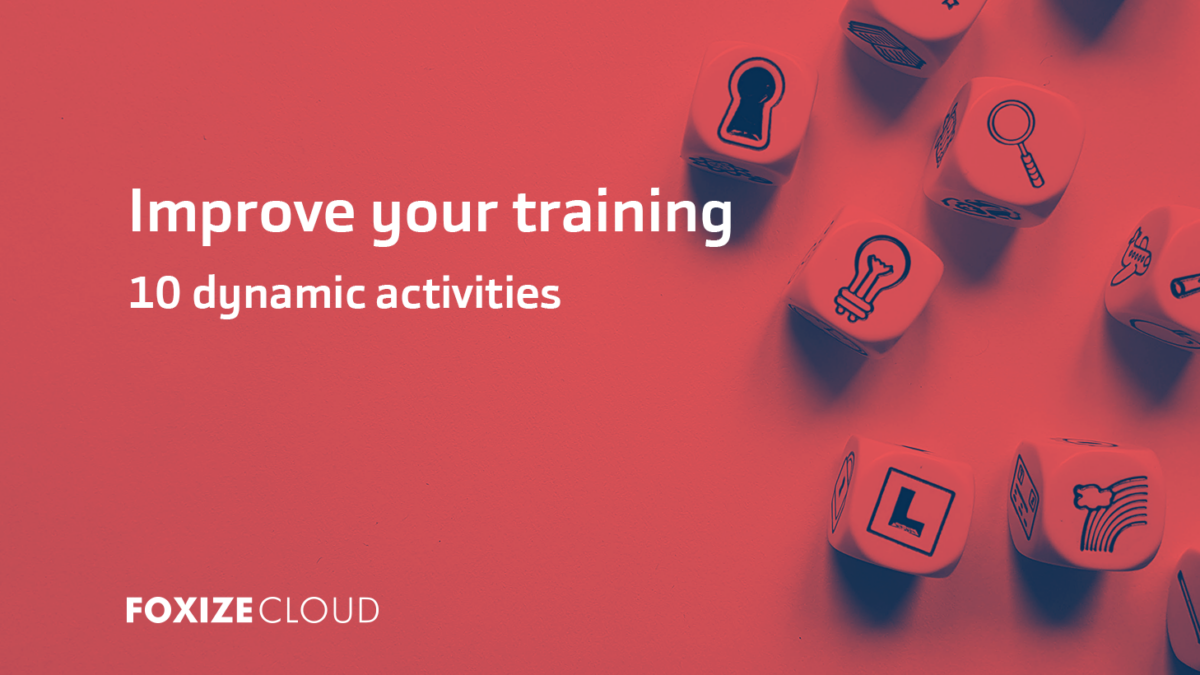Delivering training has evolved through the years, especially in this digital context. The training model is tending towards a more dynamic and digital aspect. For example, masterclasses are divided into 80% theory and 20% practical exercises, while workshops focus 100% on activities.
In addition to these two examples, we can find many other ways to dynamize our classes. We list a series of activities and tools to improve your training.
1. Trainer’s explanation
Trainer’s explanation is the main basis of every course. It can be only verbal or supported by other materials such as videos, presentations or a blackboard.
How can we improve these explanations? First, we must capture the attention of the attendees, a good icebreaker is always a good option. It helps to put attendees in context and make them more predisposed to listen and participate.
An interesting dynamic is to start class with a story that links to the topic of the course. If we want to motivate attendees to participate, we can start the training with a round of questions related to the subject of the course, or create a network of words related to the topic to see the perspectives that the participants have regarding the course.
We can also support our explanation with a presentation, thus offering a better understanding and management of students' attention. Remember that presentations are intended to support, not explain. It is not about capturing all the content of the training in them, but about those most relevant points.
2. Cases
Through cases, we can exemplify the theory taught through problems of real companies or personal experiences. Not only does it put what has been learned in context, it is also a good mechanism to generate discussion.
We can offer these cases ourselves or work with the personal cases that the participants provide us so it will be easier for them to see the possible applications of what has been learned.
3. Diagrams and Charts
Charts and Diagrams help us reinforce the teacher’s explanations, thus improving the understanding. There are dozens of formats and tools for making diagrams. Scott Berinato's “Good Charts” book will help you create visual charts to help convey your idea. One of them is the Business Canvas Model, a simple and visual model to analyze business models.
Creately.com is an incredible tool to make diagrams, with more than 50 formats. It is very intuitive to use and lets you create diagrams in real time. You can also find online tools like Popplet, Blubb.us or Milanote.
4. Discussions
Of all the possible activities, discussions might be the easiest one to carry out and it achieves very good results. For good discussions to emerge, it is important that there are different views of an issue among attendees. To do this, one possible dynamic is to divide the group into two points of view, regardless of personal preference. Among the members of the same group they should look for points that support them in their debate in order to present them in front of the opposing team, and at the same time be able to refute the points of the other. It is important that in both groups there is a representative, who will give voice to the team, and that you, the trainer, assume the role of moderator to facilitate the discussion. At the end, the trainer will make a closing that links the opinions of the attendees with the topic of the training.
5. Individual exercises
The idea of these exercises is that the participants put into practice what they have learned individually, solving a task on their own. The statement of the exercise should be clear, explaining what you want them to do and how. This activity is useful when the topic of the training is related to individual skills, such as organization or writing. The result can be presented to the rest of the attendees, be corrected by the trainer, or remain as a personal reflection.
6. Group dynamics
The assistants are grouped in more or less small groups to solve a task, for example developing a project. This type of activity mixes individual skills with teamwork. These dynamics favor relationships and group work, so it may be interesting to do them with already established work groups. The result will be presented in front of the class or corrected by the trainer.
7. Live polls
To test the learned knowledge or to generate discussions among them, we can create live polls. There are tools such as Mentimeter or Kahoot that allow you to create online polls with which you can participate through mobile devices or computers. The trainer shares the questions with all the possible answers and the participants must choose the correct one. It has a gamification point, since some of these apps have a ranking system.
Other tools such as Playposit or HapYak allow integrating polls, surveys and other functionalities in videos, allowing students and the teacher to assess the level of knowledge and understanding of the syllabus.
8. Roleplay
Roleplay consists of putting yourself in someone's shoes to solve a challenge. This dynamic will help participants to take perspective of different situations and learn new points of view. For example, in a training on giving feedback, it is important that we know how the person receiving the feedback feels.
This dynamic is also worked on a lot in group exercises, where, when carrying out a task, team members must adopt certain roles, usually one with which they are not familiar.
9. Gamification
Gamification is not an activity in itself, it is a mechanic to complement training and motivate participants. As the name suggests, gamification turns tasks into challenges, and through competition you get points to climb the ranking and win prizes. This technique will capture the attention of the attendees and allow them to become more involved in the course and activities. Remember, it is not about playing, it is about applying the mechanics of the games in the training activities.
10. Recording
Today, everyone has a camera in their mobile phone, and we can easily record videos. What if we tell you that students get more involved with what they are learning by filming themselves? These are group and individual dynamics where students must record themselves explaining the subject or solving an exercise. This will also serve as a compilation of the training for both the student (notes) and the trainer (examples of exercises).
In conclusion, the content must be aligned with the objectives of the training, and we must look for forms and methods that adapt to it and facilitate its assimilation. What is your ideal method? Put it into practice in Foxize Cloud, your online and face-to-face training management platform. We give you 1 month free trial, without obligation.


